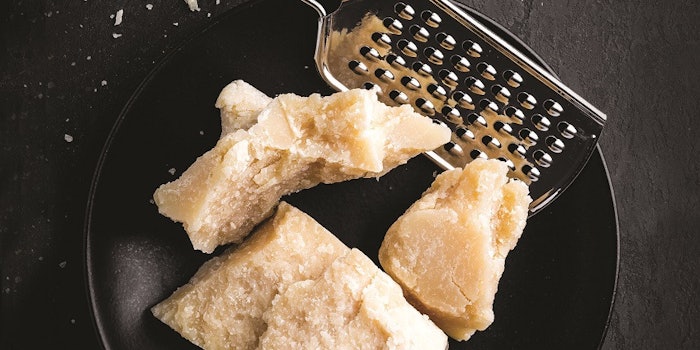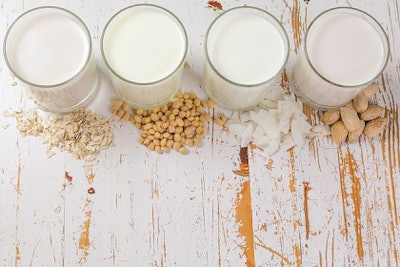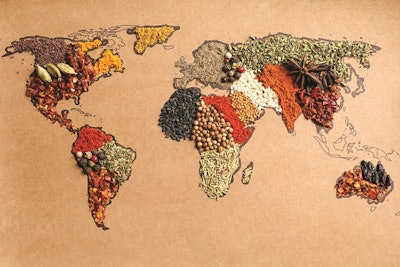
Microorganisms and enzymes play an essential role in the development of taste and flavors in the dairy products we enjoy. These include the conversion of milk sugar to buttery aroma molecules (e.g., yogurt) or the metabolism of casein to flavorful peptides (e.g., Parmesan cheese). Although consumers are still purchasing dairy products, they have also increased the demand for plant-based alternatives – a trend that continues to grow. With this is mind, it’s important to consider the role thermal processing and microorganisms play in creating traditional dairy flavors, so we can continue to evolve vegan flavor profiles.
Traditional Dairy Flavors
Thermal processing and the addition of microorganisms play a fundamental role in the flavor development of dairy products we enjoy every day, such as the condensed milk flavor profile of desserts like custard and flan; the tangy sour taste of yogurt and kefir; and the nutty taste of aged cheeses like Parmigiano and Gruyere. Many of the key flavor components arise from heating milk to form cooked notes; fermentations by lactic acid bacteria to create sour, cultured and buttery notes; and biochemical reactions, which help to develop infinite types of cheese tastes. Regional differences in traditions, cultures and taste also play a unique role in innumerable dairy based products around the globe.

Milk fermentation by lactic acid bacteria is a key process that helps create products we have been consuming for a long time. These fermented products contain two or more strains of lactic acid bacteria that primarily convert lactose to lactic acid. This adds to the sour, tangy, refreshing taste in cultured dairy products such as yogurt, kefir and sour cream. Other lactic acid bacteria (Llactis subsp diacetylactis or L. cremoris) form acetoin and diacetyl from residual or added citrate, which are essential compounds for creamy profiles and adding buttery notes. In addition, fermented products also contain other lactic acid bacteria and Bifidobacterium strains, some of which have known health beneficial properties such as gut health and immunity. When lactose interacts with whey protein during the thermal process, it’s transformed into sweet brown components – furans and derivatives are formed that lend a sweet, caramel, cooked note that aids in desserts or milk-based beverage products. These compounds also form the base of the ripe notes of fruit flavors.
Milk fat has a mild fatty, creamy taste but is transformed to many different flavor components via thermal processes or the action of microorganisms. For example, milk fat can be cyclized to lactones and is oxidized to ketones at high temperatures. These conversions add a creamy, rich taste to baked goods or desserts. Thermal processes can also lead to the formation of delta lactones from milk fat, which are crucial to the creamy taste of dairy products. In contrast, gamma lactones are formed in fruits and are key to the taste and development of fruit flavors such as peaches. Milk fat can also be broken down by lipases present in microorganisms to a range of free fatty acids. The release depends on the type of enzyme present in the culture. Butyric acid is important for cheddar and blue cheeses, while the lipase liberates much of the fatty acids in hard Italian cheeses, contributing to the soapy and waxy taste. Low levels of fatty acids are also important for fruit flavors. Fatty acids are converted to esters in cheeses when advantageous yeasts are able to produce alcohol, which leads to esterification. Esters typically form late in the ripening process when the pH is more suitable for the growth of yeasts. These esters form in large amounts during fruit ripening and are very important for the development of tropical fruit flavors.
Casein and whey derivatives add milky, sweetness to dairy products. Similar to lactose and milk fat, casein and whey are transformed into flavor compounds during thermal processes or by microorganisms. Whey contains sulfur amino acids, which can create cooked and meaty notes during heating. Some of these compounds include dimethyl sulfide, methanethiol and others that create a sulfur taste of warm milk. This can increase the liking for consumers in some regions of the globe, while for others it can be polarizing. Whey can also interact with carbonyls, such as acetoin, to create heterocyclic compounds, which can have off notes that rapidly develop within a few days. In cheeses, casein breaks down to a variety of peptides and amino acids by proteases present in microorganisms. The resulting flavor can range from bitter to savory to umami and add value to the characteristic taste of products such as cheddar, Parmesan and Swiss cheese. Amino acids also form a variety of aroma compounds catalyzed by heat or microorganisms. These reactions lead to the formation such as isovaleraldehyde, methional or phenylacetaldehyde. All of these amino acid derivatives are key components of various fruit and savory flavors.
Dairy flavors can be used in a variety of end products. From serving as a primary flavor in consumer favorites such as Greek style yogurt and macaroni and cheese, to providing the background creamy profile in dips, puddings and sauces, to adding a depth to a nacho style seasoning or the richness to a meat dish, dairy based flavors find value across many food categories. When creating dairy flavors (or even fruit flavors), it’s important to understand the chemical and biochemical changes to the main macro component in order to develop the required flavor skeleton formulation. These flavor skeletons can then be fine-tuned to suit customer and consumer preferences. During the application stage, processing conditions and other additives being introduced in the product can also affect the final flavor formulation. Dairy flavors can range from simple formulations that replicate a cooked milk flavor or a Parmesan profile, while other formulations contain several dairy derivatives which add creaminess, or the non-volatile aspects of a cheese flavor. Besides aroma molecules, the utilization of a variety of non-volatile ingredients including enzyme-modified or other specialty or proprietary ingredients would be valuable to provide a complete dairy flavor solution.
Working With Vegan Flavor Profiles
How does all of this play a role in vegan flavor profiles? Understanding how traditional dairy flavors are created can help better flavor plant-based alternatives. The consumption of plant-based foods and dairy alternatives continues to increase due to environmental concerns and a more health conscious consumer. This will be critical in flavor development and product formulation. As we shift our tastes to accommodate newer protein sources to create dairy alternatives, adapting flavor creation to these product matrices requires new thinking. As these products increase in consumption, there are several issues to consider when developing flavor profiles including the product, source of protein used, the processing conditions and more.

A variety of plant proteins, fruits and nut milks are forming the basis of the new launches of dairy alternatives. These include nuts such as cashew, almond and coconut; fruits such as bananas; and plant proteins including soy, pea, flax and hemp. Nuts have fats – which are higher in longer chain fatty acids than milk fat – and thus, any lipase action will result in more fatty, oily taste compared to milk fat, leading to sometimes oxidized or astringent taste. Also, plant proteins may create different break down peptides when acted upon by enzymes and microorganisms, which may be more bitter or savory. Additionally, products made from plant-based fats and proteins have off-tastes of their own to overcome. These off-tastes include earthy, beany aroma and bitter taste. Thus, flavors and other flavoring components need to counter the undesired attributes and enhance the dairy profile for a consumer-preferred eating or drinking experience, and deliver on the same great taste consumers know, love and have come to expect. This is accomplished by the inclusion of maskers that can suppress bitterness, for example, or mitigate beany type off-notes.
How will dairy alternatives evolve in the coming years? How will flavor companies create and develop new types of dairy-like flavors? How will consumers’ attitudes and tastes evolve? How will we adopt fats and proteins that are available to develop products that excite consumers? These will be some of the challenges that await new flavor creations as we look to provide an authentic taste to plant-based alternatives. But, it’s also an exciting opportunity for the industry to look to global tastes and introduce bold new products utilizing the newer proteins and fats coming to the market.











